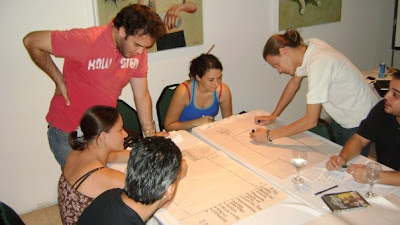 How to structure an ideation session? How do you make ethnographic data useful in a design setting?
How to structure an ideation session? How do you make ethnographic data useful in a design setting?
Biologists, engineers, and even those fence-riders, those anthropologists, who sit on the line between the humanities and the sciences, like to parse the world into its component parts. We (and I include myself in the fence-sitting crowd) like to take things apart. It helps us see how things work. We sort out what the parts are, we try to understand what is the same and what is different. We taxonomize and typologize. And when things are set in motion, we try to isolate one moment from the next, we try to inspect, document, or (in Spanish) precisar, to make clarity out of the murky water of lived experience. Which is all well and good. Except when it gets in the way.I was on day three of a three-day workshop that aimed to link ethnography and design. I'm an anthropologist: I know how to do ethnography and I have a fair idea of how to teach parts of it. I even enjoy doing it. But I'm not a designer, not a card-carring one. I do badly trying to build things (though I can put together things and sometimes make them work). Creating new things is something I wish I could do more easily; I wish I could improvise on the piano better. Seems that creating, dreaming, and thinking about what might be is different from documenting and analyzing what is going on.So there we were, day three. I had to pull the mini-ethnography practice work together and we had to have the group ideate, create, design, and dream. I had a template (partly borrowed, partly invented, but mostly borrowed) that seemed to make sense. I called Hai (thanks to Skype) and told him I was worried. How much time should I allocate? How should I structure the ideation? Should I pull forward the specifications drawn from the problems and desires that the fieldwork students had encountered in their mini-fieldwork? We kicked some ideas around, and came up with a format: start with ideas. Let them flow. Add the specs and documentation and stuff later.That seemed fine.But when it was time to explain the task to the group, I fell back on the analytic, parting and sorting and picking-apart mode of the ethnographer in the early stages of analysis. I was listing all the steps they might follow, specifying where to put this or that insight or fact, how to draw it on the page, and how the groups might organize themselves. Then one of the students provided me with a teachable moment. A student from Potosí, that most colonial and traditional of Altiplano mining towns, a linguist and semiotician, raised his hand. "There is something you might want to add to this process," he said.I was nervous enough, already. What did this guy from the Altiplano have in mind, I wondered?"It should be fun. There should be smiles and laughter." The student's face shone with Boddhisatva light as he smiled.Giggles began to bubble up from members of the group. I had been too damn serious. Ideation should be fun, getting new, goofy ideas should be happy stuff, not serious data-crunching. And without that ludic element, the ideas would not be as interesting, nor would there be as many of them.What followed was a rather riotous hour and a half of sketching and brainstorming an specifying, and—best of all—laughter.
The richness and complexity of the results told me all I needed to know. Relax more. Laugh more. Learning requires that one lower what linguists call the "affective barrier." You can't be uptight and learn much. You have to ease up and laugh to create.Labels: design research, designers, ideation, pedagogy, workshops
 We thought (okay, I thought) that it made sense to have a geek-theory blog and another blog that's a company blog, one that has shorter, more business-focused things on it.
We thought (okay, I thought) that it made sense to have a geek-theory blog and another blog that's a company blog, one that has shorter, more business-focused things on it. 